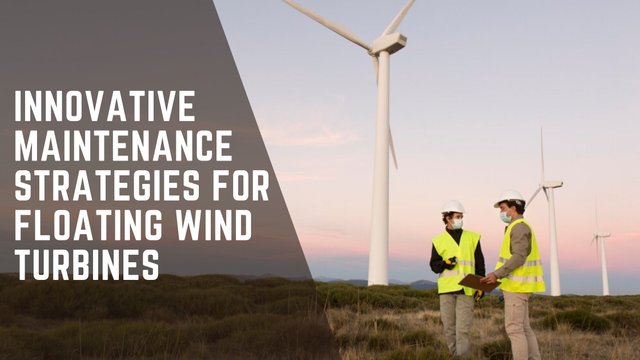.jpg)
The Challenges of Floating Offshore Wind Maintenance
Extreme Environmental Conditions
Floating wind turbines endure harsh ocean forces, including wind, waves, salty air corrosion, and biofouling, which accelerate wear and tear.
Key Facts:
- Offshore turbines face environmental loads 2-3 times greater than onshore turbines.
- Biofouling (algae and barnacle buildup) can reduce efficiency by up to 50% if not addressed.
High Maintenance Costs
Repairing components offshore is labor-intensive and costly. Maintenance accounts for nearly 30% of lifetime costs for floating wind farms, according to the IEA. With higher initial CAPEX compared to fixed-bottom systems, cost-effective solutions are essential.
Accessibility Issues
Floating turbines, often located far offshore in deep waters, are harder to access. Bad weather can delay repairs, worsening damage.
Advanced Maintenance Strategies for Floating Wind Turbines
To overcome these challenges, innovative strategies that leverage new technologies and methodologies are being deployed. Here's a breakdown of some of the most promising advancements.
1. Digital Twins for Predictive Maintenance
A "digital twin" is a virtual model of a wind turbine that helps operators simulate conditions and spot issues before failures occur.
- Case Study: At the Kincardine Offshore Wind Farm in Scotland, digital twins predicted gearbox malfunctions with 95% accuracy, preventing failures and saving millions in repairs.
- Turbines with digital twins see 30% fewer unplanned maintenance events.
2. Robotics and Autonomous Inspection
Robotics and autonomous systems have transformed offshore inspections. Underwater drones and climbing robots with sensors and cameras can inspect hard-to-reach areas, like submerged structures and blades, without human involvement.
- Example: The MIMRee project uses autonomous robots to inspect turbine blades.
- Robots can cut inspection costs by up to 40% compared to traditional methods.
3. Real-Time Monitoring Systems
Advanced sensors collect data on vibration, temperature, and wind speed, which AI analyzes to detect issues and optimize maintenance.
- Statistic: Turbines with advanced monitoring last 20% longer than those without.
- Leading companies like Ørsted and Siemens Gamesa now include sensors as standard features in next-gen turbines.
4. Dynamic Maintenance Scheduling
Weather-based scheduling tools plan maintenance during safe conditions, minimizing technician risks and delays.
- Insight: A scheduling algorithm trialed at Borssele Wind Farm in the Netherlands reduced technician downtime by 15%, saving on operational costs.
5. Innovations in Component Design
Manufacturers are creating modular components for floating turbines, enabling faster repairs. Some turbines now feature “plug-and-play” parts, cutting repair times by 25% and maximizing uptime.
Industry Insights from the Offshore Wind Conference 2025
Key takeaways from the Offshore Wind Conference 2025:
1. Collaborative Initiatives Drive Results
- Cross-industry collaboration between developers, universities, and government-funded bodies is accelerating breakthroughs in floating wind maintenance.
2. Greener Maintenance Practices
- Companies are adopting eco-friendly approaches, such as using biodegradable oils for turbines and reducing carbon emissions during inspections.
3. Enhanced Focus on Training
- Training programs for maintenance crews ensure that technicians are well-versed in handling advanced robotics, ensuring swift and safe repairs.
One of the standout discussions emphasized the role of policy support in scaling up floating wind turbine adoption, underscoring how regulations might enable smooth maintenance operations.
Frequently Asked Questions (FAQs)
Why is predictive maintenance crucial for floating wind farms?
Predictive maintenance prevents costly breakdowns by identifying potential issues early. It minimizes unplanned downtime and can save operators millions over the turbine’s lifetime.
How does biofouling affect floating wind turbines?
Biofouling decreases efficiency by adding unwanted mass and drag to the partially submerged structures. Regular maintenance and anti-fouling coatings are essential to mitigate this issue.
What is the role of robots in floating offshore wind maintenance?
Robotic systems can perform inspections in hazardous environments, making floating offshore wind maintenance safer and more cost-effective by reducing risks to human technicians.
Looking Ahead: The Future of Floating Offshore Wind Maintenance
The 5th Annual Floating Wind Europe is set to be a pivotal event in shaping the future of floating wind energy across Europe. Organized in its 5th annual iteration, this renowned event will bring together industry leaders, policymakers, researchers, and innovators to discuss the latest advancements and challenges in the field. Attendees can expect in-depth sessions on cutting-edge technologies, operational strategies, and policy frameworks that are critical to scaling floating offshore wind projects. Hosted by Leadvent Group, the conference provides unparalleled networking opportunities and a platform for collaboration aimed at driving sustainable growth in offshore wind energy. The Offshore Wind Conference 2025 is a must-attend for stakeholders dedicated to advancing renewable energy solutions and fostering a greener future.